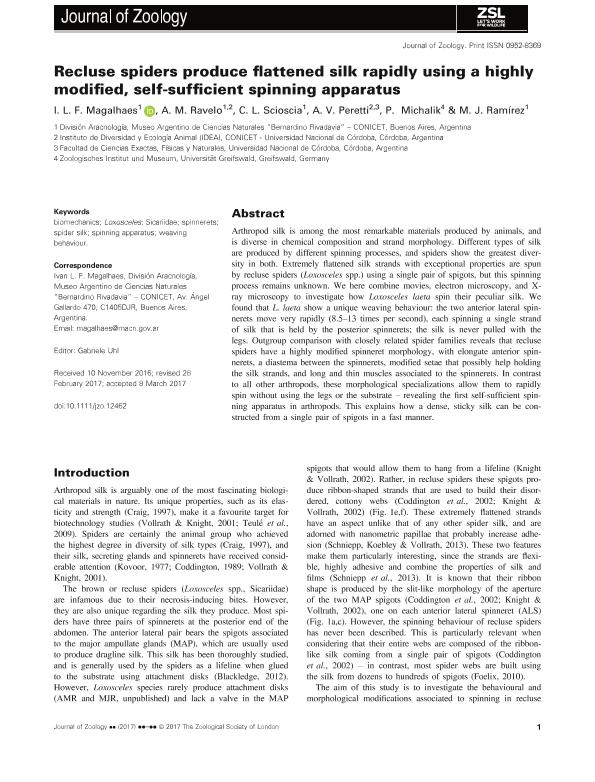Mostrar el registro sencillo del ítem
dc.contributor.author
Fiorini de Magalhaes, Ivan Luiz

dc.contributor.author
Ravelo, A. M.
dc.contributor.author
Scioscia, Cristina Luisa

dc.contributor.author
Peretti, Alfredo Vicente

dc.contributor.author
Michalik, Peter

dc.contributor.author
Ramirez, Martin Javier

dc.date.available
2018-06-07T20:48:14Z
dc.date.issued
2017-09
dc.identifier.citation
Fiorini de Magalhaes, Ivan Luiz; Ravelo, A. M.; Scioscia, Cristina Luisa; Peretti, Alfredo Vicente; Michalik, Peter; et al.; Recluse spiders produce flattened silk rapidly using a highly modified, self-sufficient spinning apparatus; Wiley Blackwell Publishing, Inc; Journal Of Zoology; 303; 1; 9-2017; 27-35
dc.identifier.issn
0952-8369
dc.identifier.uri
http://hdl.handle.net/11336/47791
dc.description.abstract
Arthropod silk is among the most remarkable materials produced by animals, and is diverse in chemical composition and strand morphology. Different types of silk are produced by different spinning processes, and spiders show the greatest diversity in both. Extremely flattened silk strands with exceptional properties are spun by recluse spiders (Loxosceles spp.) using a single pair of spigots, but this spinning process remains unknown. We here combine movies, electron microscopy, and X-ray microscopy to investigate how Loxosceles laeta spin their peculiar silk. We found that L. laeta show a unique weaving behaviour: the two anterior lateral spinnerets move very rapidly (8.5-13 times per second), each spinning a single strand of silk that is held by the posterior spinnerets; the silk is never pulled with the legs. Outgroup comparison with closely related spider families reveals that recluse spiders have a highly modified spinneret morphology, with elongate anterior spinnerets, a diastema between the spinnerets, modified setae that possibly help holding the silk strands, and long and thin muscles associated to the spinnerets. In contrast to all other arthropods, these morphological specializations allow them to rapidly spin without using the legs or the substrate - revealing the first self-sufficient spinning apparatus in arthropods. This explains how a dense, sticky silk can be constructed from a single pair of spigots in a fast manner.
dc.format
application/pdf
dc.language.iso
eng
dc.publisher
Wiley Blackwell Publishing, Inc

dc.rights
info:eu-repo/semantics/openAccess
dc.rights.uri
https://creativecommons.org/licenses/by-nc-sa/2.5/ar/
dc.subject
Biomechanics
dc.subject
Loxosceles
dc.subject
Sicariidae
dc.subject
Spider Silk
dc.subject
Spinnerets
dc.subject
Spinning Apparatus
dc.subject
Weaving Behaviour
dc.subject.classification
Otras Ciencias Biológicas

dc.subject.classification
Ciencias Biológicas

dc.subject.classification
CIENCIAS NATURALES Y EXACTAS

dc.title
Recluse spiders produce flattened silk rapidly using a highly modified, self-sufficient spinning apparatus
dc.type
info:eu-repo/semantics/article
dc.type
info:ar-repo/semantics/artículo
dc.type
info:eu-repo/semantics/publishedVersion
dc.date.updated
2018-06-04T13:55:38Z
dc.identifier.eissn
1469-7998
dc.journal.volume
303
dc.journal.number
1
dc.journal.pagination
27-35
dc.journal.pais
Reino Unido

dc.journal.ciudad
Londres
dc.description.fil
Fil: Fiorini de Magalhaes, Ivan Luiz. Consejo Nacional de Investigaciones Científicas y Técnicas. Oficina de Coordinación Administrativa Parque Centenario. Museo Argentino de Ciencias Naturales ; Argentina
dc.description.fil
Fil: Ravelo, A. M.. Consejo Nacional de Investigaciones Científicas y Técnicas. Centro Científico Tecnológico Conicet - Córdoba. Instituto de Diversidad y Ecología Animal. Universidad Nacional de Córdoba. Facultad de Ciencias Exactas Físicas y Naturales. Instituto de Diversidad y Ecología Animal; Argentina. Consejo Nacional de Investigaciones Científicas y Técnicas. Oficina de Coordinación Administrativa Parque Centenario. Museo Argentino de Ciencias Naturales ; Argentina
dc.description.fil
Fil: Scioscia, Cristina Luisa. Consejo Nacional de Investigaciones Científicas y Técnicas. Oficina de Coordinación Administrativa Parque Centenario. Museo Argentino de Ciencias Naturales ; Argentina
dc.description.fil
Fil: Peretti, Alfredo Vicente. Consejo Nacional de Investigaciones Científicas y Técnicas. Centro Científico Tecnológico Conicet - Córdoba. Instituto de Diversidad y Ecología Animal. Universidad Nacional de Córdoba. Facultad de Ciencias Exactas Físicas y Naturales. Instituto de Diversidad y Ecología Animal; Argentina. Universidad Nacional de Córdoba. Facultad de Ciencias Exactas, Físicas y Naturales; Argentina
dc.description.fil
Fil: Michalik, Peter. Universität Greifswald; Alemania
dc.description.fil
Fil: Ramirez, Martin Javier. Consejo Nacional de Investigaciones Científicas y Técnicas. Oficina de Coordinación Administrativa Parque Centenario. Museo Argentino de Ciencias Naturales ; Argentina
dc.journal.title
Journal Of Zoology

dc.relation.alternativeid
info:eu-repo/semantics/altIdentifier/doi/https://dx.doi.org/10.1111/jzo.12462
dc.relation.alternativeid
info:eu-repo/semantics/altIdentifier/url/https://zslpublications.onlinelibrary.wiley.com/doi/full/10.1111/jzo.12462
Archivos asociados
